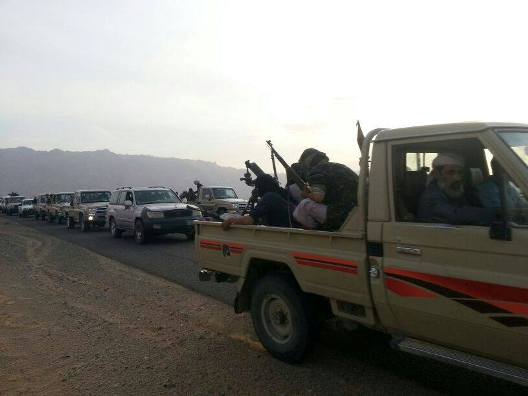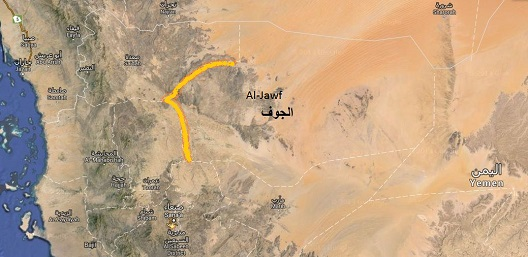 The Houthis, a Shia rebel group operating outside of government control primarily in the northern Saada governorate, have aggressively pushed for influence in the neighboring territories. The Houthi approach into al-Jawf and Marib governorates raises a great deal of concern among the tribes in those areas. Popular committees allied with the Islamist Islah party—a powerful political party with nationwide reach that includes Muslim Brotherhood-affiliated adherents, tribal sheikhs, and other Islamist-oriented supporters—have moved to stop a perceived Houthi power grab. Intense clashes over the past month have become alarmingly sectarian in nature, with hundreds of young Yemeni tribesmen mobilized under intense religious propaganda from both Islah and Houthi leaders. President Abdrabbo Mansour Hadi, focusing on negotiating an end to Houthi protests in Sana’a, has not paid enough attention to this ongoing conflict to the east—one that threatens to spiral out of control.
The Houthis, a Shia rebel group operating outside of government control primarily in the northern Saada governorate, have aggressively pushed for influence in the neighboring territories. The Houthi approach into al-Jawf and Marib governorates raises a great deal of concern among the tribes in those areas. Popular committees allied with the Islamist Islah party—a powerful political party with nationwide reach that includes Muslim Brotherhood-affiliated adherents, tribal sheikhs, and other Islamist-oriented supporters—have moved to stop a perceived Houthi power grab. Intense clashes over the past month have become alarmingly sectarian in nature, with hundreds of young Yemeni tribesmen mobilized under intense religious propaganda from both Islah and Houthi leaders. President Abdrabbo Mansour Hadi, focusing on negotiating an end to Houthi protests in Sana’a, has not paid enough attention to this ongoing conflict to the east—one that threatens to spiral out of control.

Map of Yemen, highlighting the conflict zones between the Houthi rebels fighting the Islah party and Islamist supporters.
According to local sources, Islah has actively recruited young fighters from its base to defend the Sunni tradition against rawafedh (rejectionists), a term commonly used to describe the Houthi’s religious base—the Zaidi Shi’a. “Thanks to you and to your sons for sacrificing their blood on the front lines day and night to protect you, your religion, and honor,” said Saleh Arrawsa, an Islah leader during an August gathering for tribesmen. Houthi propaganda, on the other hand, characterizes the fight as a war against the Islamic State (ISIS) or takfiri militants in a blatant condemnation of the Islah party and its supporters, claiming that the party uses al-Qaeda militants in its war to eliminate its political opponents.
The war between the Islah party and its affiliated tribes against Houthis centered in al-Jawf has flared up periodically since 2011 and all attempts to resolve the conflict have failed. The current round of fighting started in July 2014, less than two weeks after Houthi rebels took over the city of Amran, near the capital city of Sana’a. The fighting intensified as Houthi rebels sought to seize routes to the capital, where their supporters have staged weeks of escalating protests against the government. The escalation has provoked an intense propaganda campaign of hatred and intolerance that dominates the discourse of activists from both sides in the press and on social media.
Although the Islah party and Houthis are traditional rivals, the tribes genuinely fear that the Houthi rebels plan to expand their sphere of influence beyond their traditional homeland of the Saada province and parts of al-Jawf, where they have complete control and de facto autonomy from the central government. The tribes from Marib and al-Jawf view Houthis as a direct threat to stability and the future development of the region; as such, they have united with Islah in a common goal to prevent the Houthi expansion. Explaining the alliance, “the tribes would rather work with Islah than Houthis. Unlike Houthis, Islah does not force things upon the tribe,” said Mahdi Balgheith, a civil society activist from Marib.
Some tribal leaders and young activists, however, see the continuation of the conflict as the greater threat, preferring to reach a peace settlement. The conflict has claimed the lives and wounded hundreds, with nearly 8,000 people displaced. But beyond that, the increased sectarian tone—strange to a tribal culture where Shaf’i and Zaidi Muslims have lived in peace for centuries—threatens to further destabilize the already fragile region (the Shaf’i and Zaidi sects represent moderate versions of Sunni and Shia Islam, respectively). Given that Marib, al-Jawf, and al-Baidha suffer from the highest and most complex tribal conflicts in the country, the impact of this war could tear the social fabric apart. “Already you hear individuals threatening to take revenge from others who fight with the opposite side. Revenge killings caused by this conflict will likely stay for many years to come,” said Nasser Ku’lan, a young tribal leader from the Jedaan tribe.
A more immediate concern, however, is how the emerging sectarian narrative has invited al-Qaeda to the area. Local sources and news indicate that al-Qaeda operatives from al-Baidha, Shabwa, Abyan, and other governorates have been drawn to Marib and al-Jawf by the prospect of fighting against the Houthis, who they consider infidel Shi’a. One local source said that the militants, who come from local Yemeni tribes, avoid revealing their affiliation with al-Qaeda. Nonetheless, an increased al-Qaeda presence will add another dimension that will further complicate the conflict. If al-Qaeda gains control and influence in these regions, it will take advantage of every opportunity to attack the Houthis and the government (viewed as enemies to al-Qaeda), further destabilizing the area and lessening the chances for a political solution to Houthi-tribal tensions. In economic terms, losing control of the region will also jeopardize the safety of the road that connects Marib with Sana’a. Marib, the center of oil production in the country, hosts infrastructure that has already come under repeated attack. Instability could lead to a disruption in oil, gas, and electricity to the capital city and the rest of the country, depriving the central government of one of its key revenue sources.
In Sana’a, all efforts are focused on negotiations between Hadi and (presumably) the Houthi leadership in Saada to find a compromise agreement that will allow the Houthis to vacate their protest sites in Sana’a. But the fighting in these tribal areas does not seem to be part of the discussion. According to prominent Marib Sheikh Derhem Adh’ama’a, it would take a conscious decision from the head of the rebel group Abdulalik al-Houthi in Saada and the Islah leadership in Sana’a for the fighting to stop. Sheikh Mufarreh Beheibeh, a member of the mediation committee that President Hadi formed to negotiate a ceasefire between the two fighting parties, indicates that conflict resolution efforts have failed over the intense rhetoric and constant clashes. He warns that ongoing between the Houthis and President Hadi in Sana’a must include negotiations to end the conflict in Yemen’s east. Without it, Marib and al-Jawf will continue to feed armed conflict between Houthis and Islah. “This is very serious. If Houthis take over the area or the fighting continues, life support for Sana’a will be cut. There will be no oil, no electricity and no gas,” he added.
The current negotiations between the Houthis and Hadi in Sana’a need to include a condition for both the Houthis and Islah to establish an immediate truce, enter serious negotiations, and stop the media war. Both parties must pull their fighters out of al-Jawf and Marib. As an immediate measure, President Hadi must urgently deploy sufficient government forces to the conflict zone to prevent clashes from erupting again and facilitate relief and humanitarian assistance to displaced and affected people. Working with prominent tribal leaders from the area, President Hadi can prevent tribesmen from joining either side and help mitigate the impact of the war on tribal conflicts. A strong military presence could help deescalate the conflict and create an opening for a political settlement. Without these measures, the conflict could threaten to consume the region—and Sana’a with it.
Nadwa Al-Dawsari is a Yemeni conflict specialist and civil society activist.
Image: Dozens of vehicles filled with anti-aircraft weapons and armed men from the Murad tribe—one of the five great tribes of the Marib governorate—drive hurriedly to support the tribal popular committees in their fight against Houthi rebels. (Photo: Murad Facebook page)

